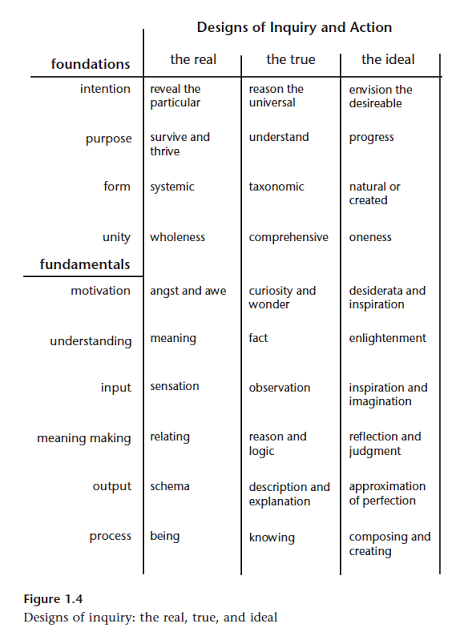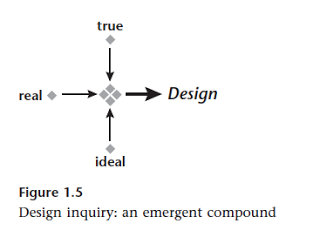Extending Churchman’s inquiring systems to design, by @estolter and Harold G Nelson with (i) the true, (ii) the ideal, and (iii) the real.
… in the chapter “The Ultimate Particular” […] we discuss three forms or designs of inquiry and action that humans can engage in. We suggest “… that design, as presented in this book, is based on a compound form of inquiry, composed of true, ideal, and real approaches to gaining knowledge.” It is possible to also make the case that research and science also in most cases consists of compound forms of these three. There is not simple and direct mapping between them even though it may be tempting to assume that.
I will not here go into any detail about this, just copy two of the schemas we use in the chapter to show what kind of considerations are involved when anyone makes a decision on how to design a particular form of inquiry.
In Figure 1.4 (below) we present a schema that lays out several aspects of inquiry and action and how they can be understood for each of the three forms of inquiry, that is, the real, the true and the ideal. This is a quite rich schema with dense concepts, but reading each line carefully gives insights about how different the three are, but also where they are somewhat overlapping. So, in making choices about what form of inquiry to choose in your research or design, a schema like this may help since it not only explains but also provides with concepts that can guide the understanding of purpose and measure of success. For instance, you can examine what your intention is, what you motivation is, what your preferred form of understanding is, etc. Given any choice also tells you what the measure fo success should be. So, if you are truly looking for inquiry for understanding (under ‘fundamentals’) that can lead to ‘enlightenment’ of some kind, it is not appropriate to see ‘facts’ to be part of the measure of success.
However, choosing a research approach or a design approach is not a simple question of deciding which ‘design of inquiry and action’ to “use”. The richness and specifics of the particular situation, your purpose and intention leads to complex considerations regarding how all three forms can inform and enrich an inquiry. This is shown in Figure 1.5 below.
Design or research is never a question of finding out what the correct or best existing approach is, instead it is a complex process of judgment that weighs all aspects in an attempt to reach an approach that makes sense, that is guided by intention, that has a purpose and is based on a clear understanding of what the measure of success is.
Forms of inquiry in design and research | Erik Stolterman | May 17, 2013 | Transforming Grounds at http://transground.blogspot.com/2013/05/forms-of-inquiry-in-design-and-research.html.


